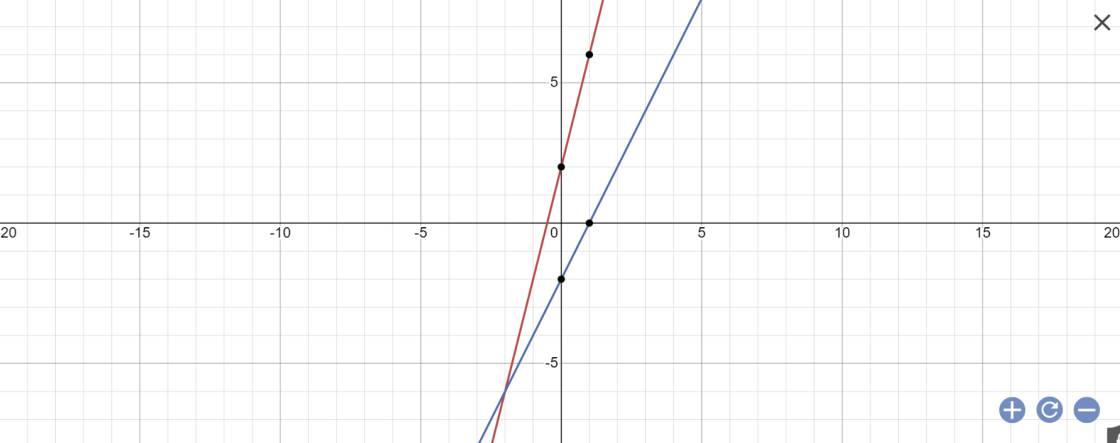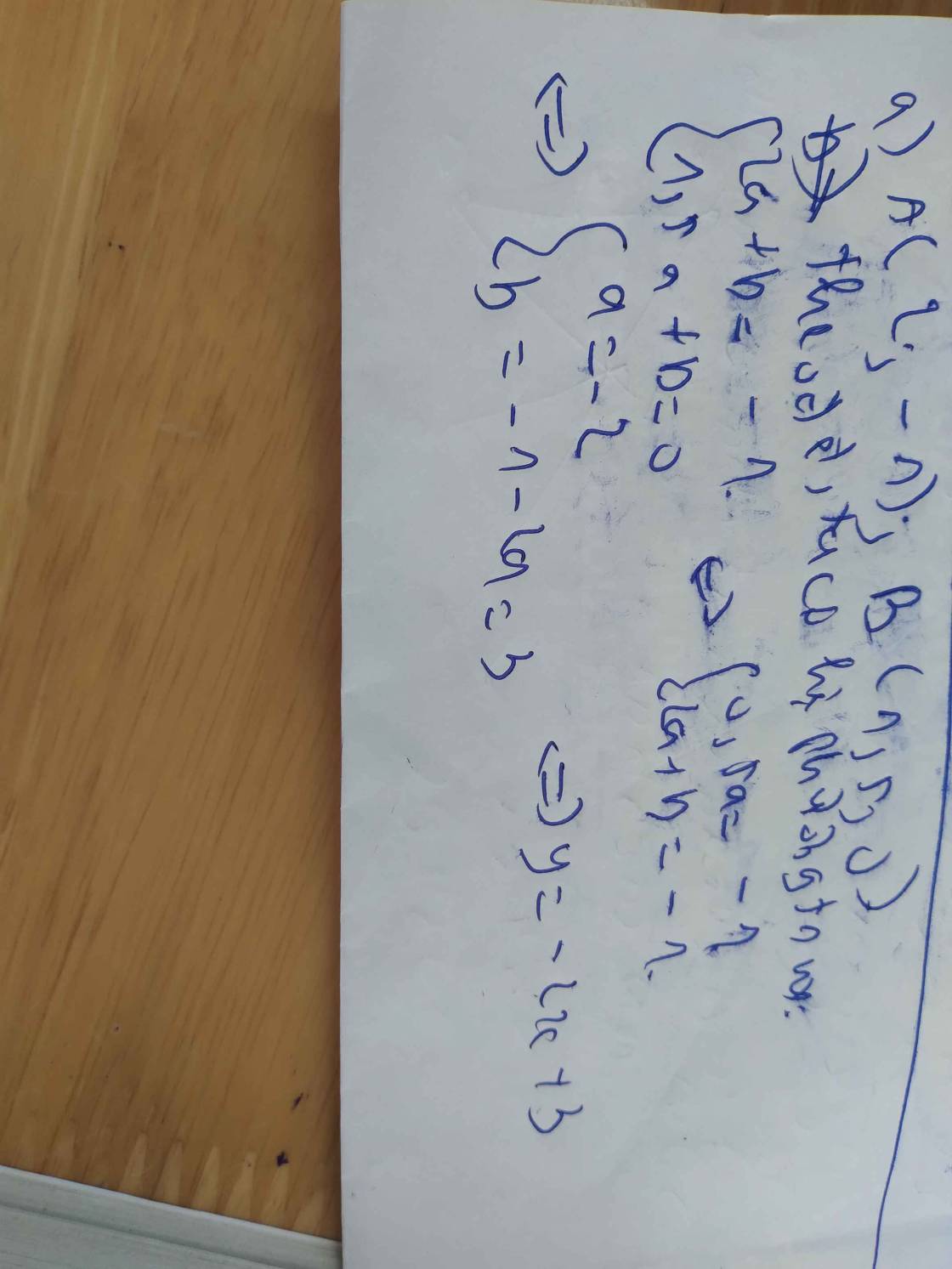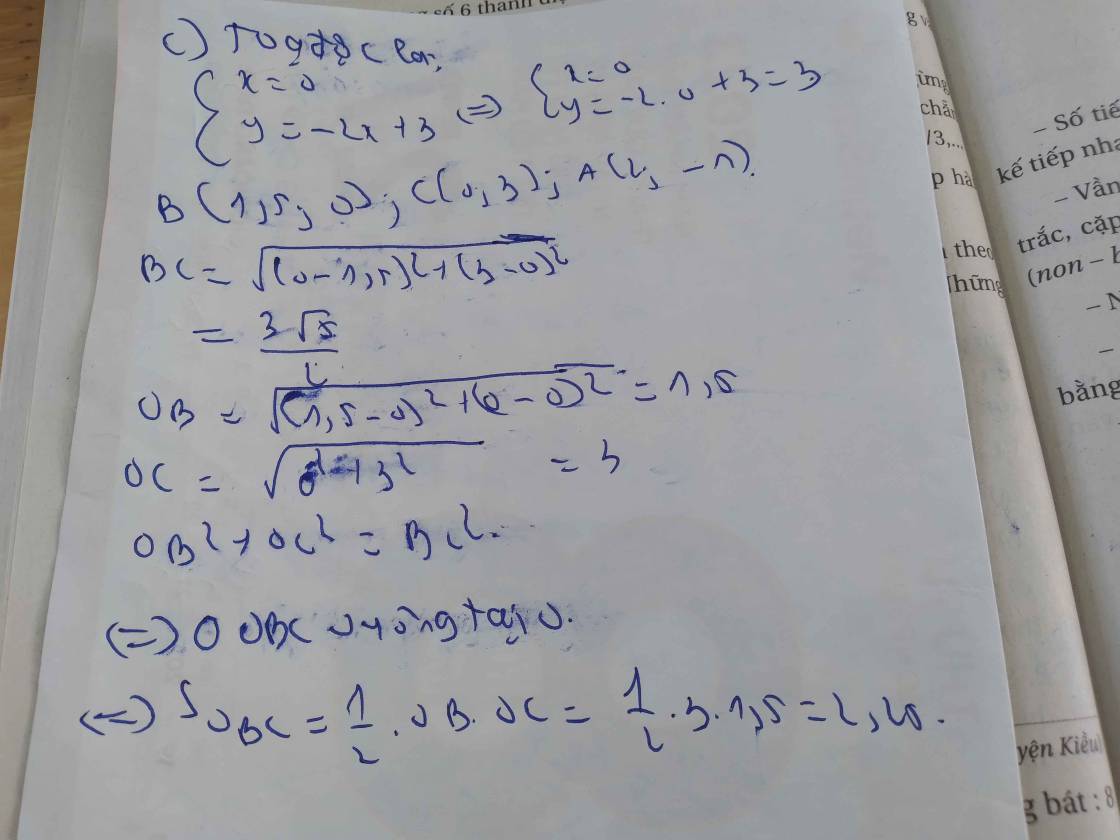Hãy nhập câu hỏi của bạn vào đây, nếu là tài khoản VIP, bạn sẽ được ưu tiên trả lời.

b) Vì C(xC,yC) là giao điểm của hai đường thẳng y=x+2 và y=-2x+5 nên hoành độ của C là nghiệm của phương trình hoành độ giao điểm có hai vế là hai hàm số của y=x+2 và y=-2x+5
hay x+2=-2x+5
\(\Leftrightarrow x+2+2x-5=0\)
\(\Leftrightarrow3x-3=0\)
\(\Leftrightarrow3x=3\)
hay x=1
Thay x=1 vào hàm số y=x+2, ta được:
y=1+2=3
Vậy: C(1;3)
Vì A(xA;yA) là giao điểm của đường thẳng y=x+2 với trục hoành nên yA=0
Thay y=0 vào hàm số y=x+2, ta được:
x+2=0
hay x=-2
Vậy: A(-2:0)
Vì B(xB,yB) là giao điểm của đường thẳng y=-2x+5 với trục hoành Ox nên yB=0
Thay y=0 vào hàm số y=-2x+5, ta được:
-2x+5=0
\(\Leftrightarrow-2x=-5\)
hay \(x=\dfrac{5}{2}\)
Vậy: \(B\left(\dfrac{5}{2};0\right)\)
Độ dài đoạn thẳng AB là:
\(AB=\sqrt{\left(xA-xB\right)^2+\left(yA-yB\right)^2}\)
\(\Leftrightarrow AB=\sqrt{\left(-2-\dfrac{5}{2}\right)^2+\left(0-0\right)^2}\)
\(\Leftrightarrow AB=\sqrt{\left(-\dfrac{9}{2}\right)^2}=\dfrac{9}{2}=4,5\left(cm\right)\)
Độ dài đoạn thẳng AC là:
\(AC=\sqrt{\left(xA-xC\right)^2+\left(yA-yC\right)^2}\)
\(\Leftrightarrow AC=\sqrt{\left(-2-1\right)^2+\left(0-3\right)^2}\)
\(\Leftrightarrow AC=\sqrt{18}=3\sqrt{2}\left(cm\right)\)
Độ dài đoạn thẳng BC là:
\(BC=\sqrt{\left(xB-xC\right)^2+\left(yB-yC\right)^2}\)
\(\Leftrightarrow BC=\sqrt{\left(\dfrac{5}{2}-1\right)^2+\left(0-3\right)^2}\)
\(\Leftrightarrow BC=\sqrt{\dfrac{45}{4}}=\dfrac{3\sqrt{5}}{2}\left(cm\right)\)
Chu vi của tam giác ABC là:
\(C_{ABC}=AB+AC+BC\)
\(\Leftrightarrow C_{ABC}=4.5+3\sqrt{2}+\dfrac{3\sqrt{5}}{2}\simeq12.10cm\)
Nửa chu vi của tam giác ABC là:
\(P_{ABC}=\dfrac{C_{ABC}}{2}\simeq\dfrac{12.10}{2}=6.05cm\)
Diện tích của tam giác ABC là:
\(S_{ABC}=\sqrt{P\cdot\left(P-AB\right)\cdot\left(P-BC\right)\cdot\left(P-AC\right)}\)
\(=\sqrt{6.05\cdot\left(6.05-4.5\right)\cdot\left(6.05-3\sqrt{2}\right)\cdot\left(6.05-\dfrac{3\sqrt{5}}{2}\right)}\)
\(\simeq6.76cm^2\)

b: Tọa độ điểm C là:
\(\left\{{}\begin{matrix}2.5x+3=-0.5x+1.5\\y=2.5x+3\end{matrix}\right.\Leftrightarrow\left\{{}\begin{matrix}3x=-1.5\\y=2.5x+3\end{matrix}\right.\Leftrightarrow\left\{{}\begin{matrix}x=-\dfrac{1}{2}\\y=\dfrac{5}{2}\cdot\dfrac{-1}{2}+3=3-\dfrac{5}{4}=\dfrac{7}{4}\end{matrix}\right.\)

a: Phương trình hoành độ giao điểm là:
\(\dfrac{1}{4}x^2=2x-3\)
\(\Leftrightarrow x^2=8x-12\)
\(\Leftrightarrow\left[{}\begin{matrix}x=2\\x=6\end{matrix}\right.\)
\(\Leftrightarrow\left[{}\begin{matrix}y=\dfrac{1}{4}\cdot2^2=1\\y=\dfrac{1}{4}\cdot6^2=9\end{matrix}\right.\)

\(b,\) Tọa độ giao điểm 2 đường thẳng là:
\(\left\{{}\begin{matrix}y=-2x+4\\y=x+1\end{matrix}\right.\Leftrightarrow\left\{{}\begin{matrix}x+1=-2x+4\\y=x+1\end{matrix}\right.\\ \Leftrightarrow\left\{{}\begin{matrix}x=1\\y=2\end{matrix}\right.\Leftrightarrow A\left(1;2\right)\)
Tọa độ giao điểm 2 đường thẳng với trục hoành là
\(\left\{{}\begin{matrix}y=0\\\left[{}\begin{matrix}y=-2x+4\\y=x+1\end{matrix}\right.\end{matrix}\right.\Leftrightarrow\left\{{}\begin{matrix}y=0\\\left[{}\begin{matrix}4-2x=0\\x+1=0\end{matrix}\right.\end{matrix}\right.\Leftrightarrow\left\{{}\begin{matrix}y=0\\\left[{}\begin{matrix}x=2\\x=-1\end{matrix}\right.\end{matrix}\right.\)
\(\Leftrightarrow B\left(2;0\right),C\left(-1;0\right)\)

a:

b: phương trình hoành độ giao điểm là:
4x+2=2x-2
=>4x-2x=-2-2
=>2x=-4
=>x=-2
Thay x=-2 vào y=4x+2, ta được:
\(y=4\cdot\left(-2\right)+2=-8+2=-6\)
Vậy: M(-2;-6)
c: Tọa độ A là:
\(\left\{{}\begin{matrix}y=0\\4x+2=0\end{matrix}\right.\Leftrightarrow\left\{{}\begin{matrix}y=0\\4x=-2\end{matrix}\right.\Leftrightarrow\left\{{}\begin{matrix}y=0\\x=-\dfrac{1}{2}\end{matrix}\right.\)
Tọa độ B là:
\(\left\{{}\begin{matrix}y=0\\2x-2=0\end{matrix}\right.\Leftrightarrow\left\{{}\begin{matrix}y=0\\2x=2\end{matrix}\right.\Leftrightarrow\left\{{}\begin{matrix}y=0\\x=1\end{matrix}\right.\)
Vậy: B(1;0); A(-1/2;0)
d: M(-2;-6); B(1;0); A(-1/2;0)
\(MA=\sqrt{\left(-\dfrac{1}{2}+2\right)^2+\left(0-6\right)^2}=\dfrac{3\sqrt{17}}{2}\)
\(MB=\sqrt{\left(1+2\right)^2+\left(0+6\right)^2}=3\sqrt{5}\)
\(AB=\sqrt{\left(-\dfrac{1}{2}-1\right)^2+\left(0-0\right)^2}=\dfrac{3}{2}\)
Chu vi tam giác MAB là:
\(C_{MAB}=MA+MB+AB=\dfrac{3}{2}+3\sqrt{5}+\dfrac{3\sqrt{17}}{2}\)
Xét ΔMAB có \(cosAMB=\dfrac{MA^2+MB^2-AB^2}{2\cdot MA\cdot MB}=\dfrac{9}{\sqrt{85}}\)
=>\(sinAMB=\sqrt{1-\left(\dfrac{9}{\sqrt{85}}\right)^2}=\dfrac{2}{\sqrt{85}}\)
Diện tích tam giác MAB là:
\(S_{AMB}=\dfrac{1}{2}\cdot MA\cdot MB\cdot sinAMB=\dfrac{1}{2}\cdot\dfrac{3\sqrt{17}}{2}\cdot3\sqrt{5}\cdot\dfrac{2}{\sqrt{85}}\)
\(=\dfrac{9}{2}\)

